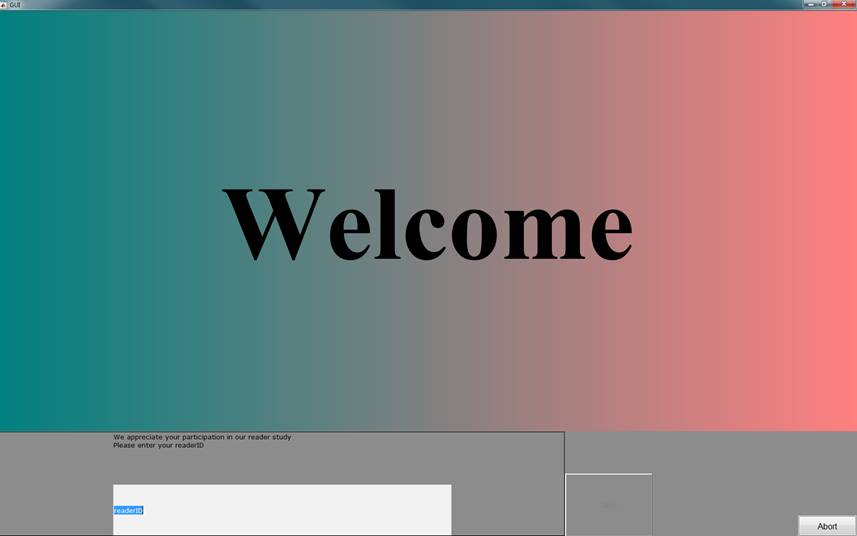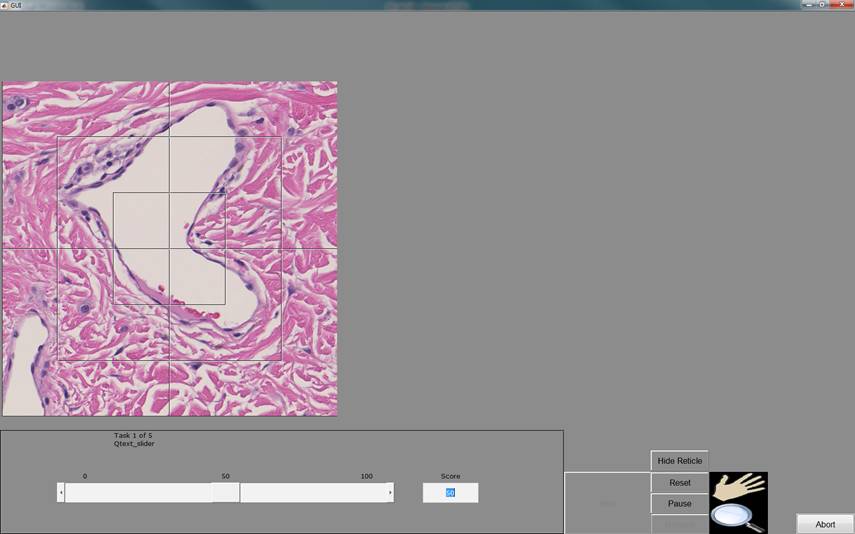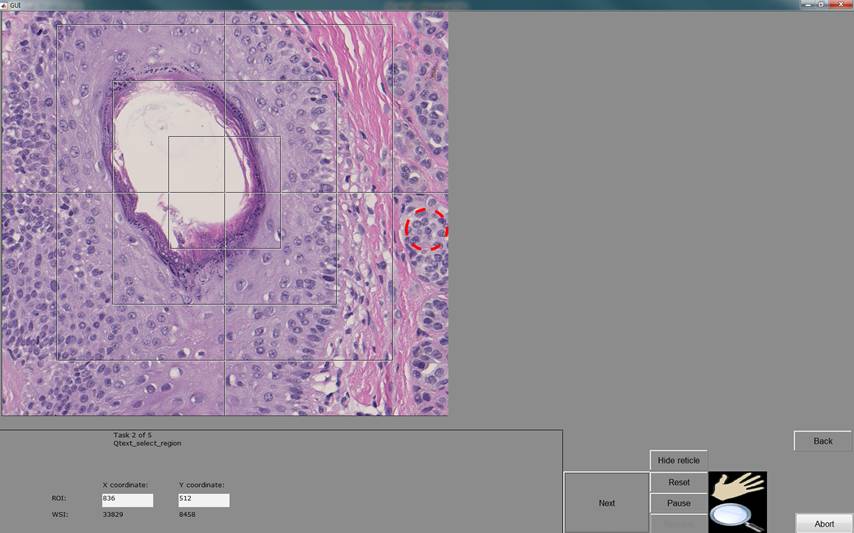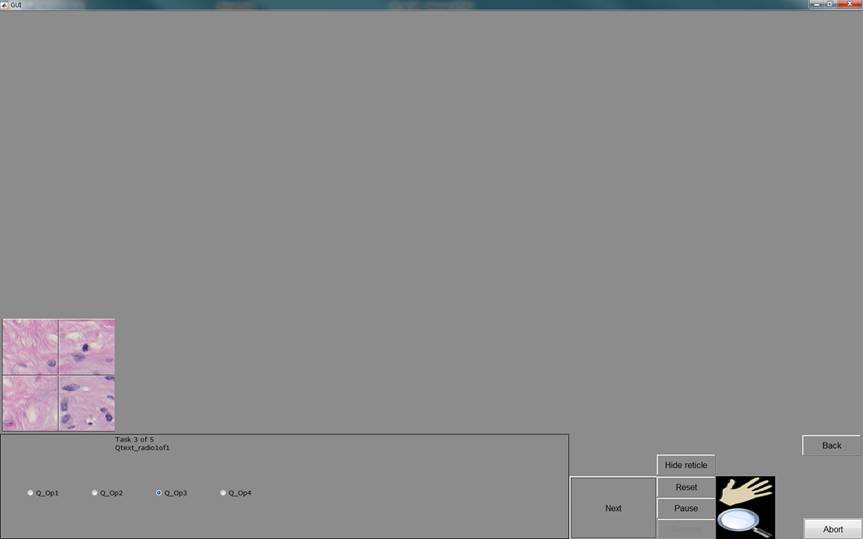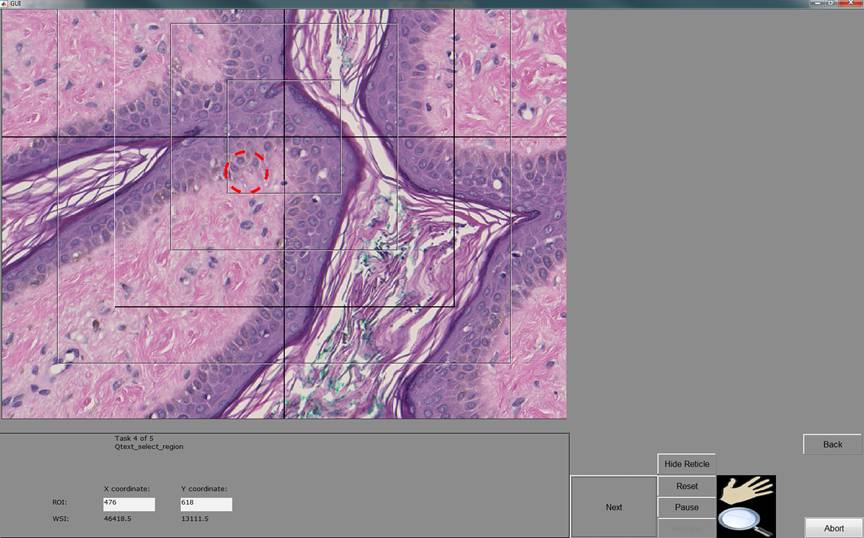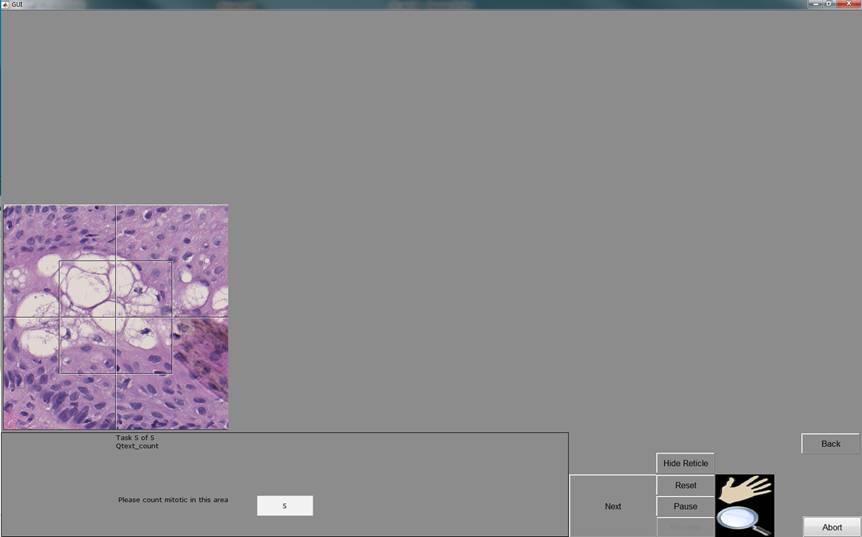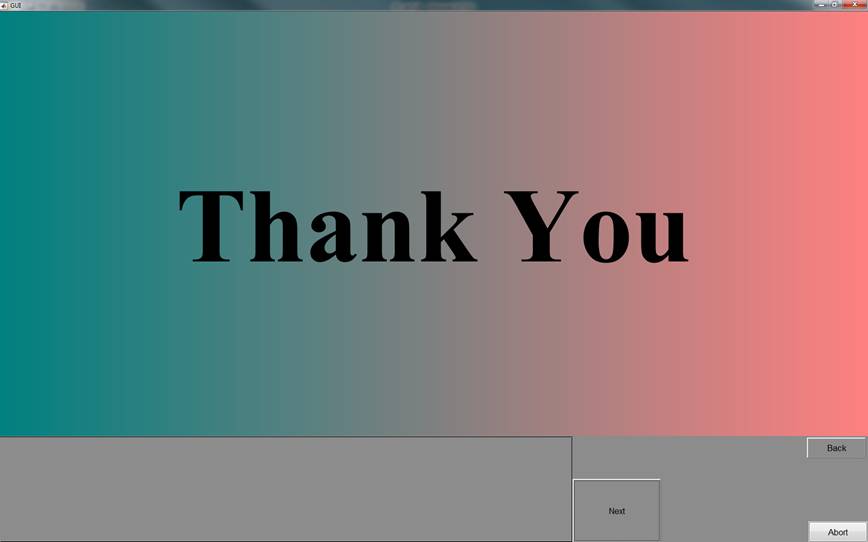The following is a conversation helping an eeDAP user get started. Start at the bottom.
—-
Hello Prarthana,
Thank you for your explanation. Here’s responses to your questions
1.The high-resolution registration refines the low-resolution registration results. They are not independent. That said, we have data on the accuracy of the registration of what the pathologist sees, measured by the microscope user.
2.The purpose of registration is to move the microscope view to the same target ROI as WSI image. We then do an automatic re-registration to fine tune this to what the pathologist/camera are already viewing. This is working very well, accuracy is 2.5 um for our first tests.
3.Yes. eeDAP can open ROI images in those formats. We suggest that you treat each ROI image as a separate WSI image in the input file. And in each task, extract the whole image. I attach a sample input file and corresponding image manySmallROI.DAPSI (7 KB, uploaded by Brandon D. Gallas 6 years 11 months ago) sampleROI.JPG. ( But this can only work in digital mode)
Regarding how to employ eeDAP for image quality evaluation: you could develop the eeDAP Matlab tasks, which are currently very modular. Each task has a unique contribution to different steps in the eeDAP workflow: • Load_Input_File • Update_GUI_Elements • NextButtonPressed • Save_Results
Check this task out, for example: (https://github.com/DIDSR/eeDAP/blob/master/src/tasks/task_count.m ). You could do your image analysis in the “Update_GUI_Elements” procedure, virtually clicking through the gui or short-cutting the gui part. Another idea would be to do your image analysis in the “Load_Input_File” procedure, include the saving of results, and shutdown eeDAP.
Yes, once our video manual is cleared, we will share it. It can help you have a better understanding of eeDAP. Please let us know, if you have other questions. Thank you.
Regards, Qi and Brandon
From: Shrestha, Prarthana
Sent: Wednesday, May 03, 2017 8:06 AM To: Gallas, Brandon D.; Gong, Qi * Cc: Gavrielides, Marios A; Abels, Esther; Kornmann, Liselotte; Nelis, Mischa Subject: RE: eeDAP registration questions
Dear Brandon and Qi
Thank you for your efforts, I highly appreciate your coaching. Please find my answers inline in italic fonts.
Regards Prarthana
From: Gallas, Brandon D. mailto:Brandon.Gallas@fda.hhs.gov
Sent: 2017 May 02 7:28 AM To: Shrestha, Prarthana; Gong, Qi * Cc: Gavrielides, Marios A; Abels, Esther; Kornmann, Liselotte; Nelis, Mischa Subject: RE: eeDAP registration questions
Hello Prarthana,
Thank you for your explanation. There are some growing pains, and we appreciate being able to coach you through it.
*Do you mind if we share this discussion?* We think that it will help others, kind of a case study. Nothing proprietary here, just trying to make the connections for you and everyone else. – It may be helpful to anyone learning the tool, I also don’t see any proprietary issue on it.
In order to help you and others, we are also going to try and do a video showing the start of a microRT study, showing the registration steps. Maybe that will help too. Would you be interested in a T-con just demo the registration process? – Definitely, it will be very appreciated.
Here’s responses to your questions 1. What magnification level of WSI is used for global registration? If it is hard coded, can we use a image ROI at the right magnification level in general image formats like bmp, png or tiff (instead of a pyramidal WSI format). a. There are two levels of global resolution: low and high. The user can set the magnification level of global registration in input file: “ mag_lres”, “mag_hres”. Low-resolution registration usually only needs to be done once for each wsi. Then a “.mat” file is saved alongside the wsi with low-resolution results. High-resolution registration must be done for each wsi each time you run a study with that wsi. You don’t use a calibration slide. You use the study wsi. – Calibration slide was proposed only for measuring registration accuracy to avoid all the complexities of measuring registration of deformable models. Are the two levels of registration are independent of each other, meaning we need to validate both of their accuracies? Or the high-resolution registration is based on top of the low-resultion registration, meaning the validation of high-resolution would be sufficient to cover the low-resolution registration?
2. Is it also possible to use only a partial content and not the full glass slide for registration? If so, we can use a number of patterns for testing registration accuracy, located in a same phantom slide . a. In global registration, software asks the user to do registration for 3 anchor points. These 3 anchors can be located anywhere on the slide, and don’t have to cross whole slide. But we recommend user spread these points out as far as possible for best results. 3. As I understood, the registration is done offline during preparation phase. During data collection the eeDAP navigates, as provided in its task-list, to the glass slide co-ordinates for microscope view and WSI ROI co-ordinates for monitor display. Then, would it be possible to obtain the registered co-ordinates for a certain magnification (say, 40x) from eeDAP and then we can use other programs to extract the registered ROI? a. No. Registration is not offline. Low-res registration can be, but high-res should not be. b. We have used ImageScope to extract and display the ROI. Essentially, for each task/location, eeDAP launches the corresponding image with ImageScope (system command line execution). Before the launch we create an xml file for the wsi specifying the FOV annotation, and this annotation is opened along with the wsi in ImageScope. The amount of programming effort will depend on how different your desired workflow is form our workflow. Do you have Matlab? Do you know Matlab? – I’ve been using Matlab in algorithm design and prototyping in regular basis, so it should not be the bottleneck. However, the whole registration and display procedure is still not clear to me – how can we employ it in the context of image quality evaluation? Maybe a demo would be a great help.
4. In the context of image quality evaluation, we do not need a complete WSI but only a cropped ROI (like bmp format) at 40x. Furthermore, the ROIs are subjected (offline) to image degradations to be presented to readers. Can we use eeDAP for displaying these degraded images and collect data on them? a. We can do that if the format is supported by bioformats (http://www.openmicroscopy.org/site/support/bio-formats5.4/supported-formats.html ). – The ROI used in image quality evaluation are not in WSI formats, but a regular image file like bmp and jpeg. Thanking you in advance.
Best regards Prarthana
From: Shrestha, Prarthana
Sent: Monday, May 01, 2017 10:21 AM To: Gallas, Brandon D.; Gong, Qi * Cc: Gavrielides, Marios A; Abels, Esther; Kornmann, Liselotte; Nelis, Mischa Subject: RE: eeDAP
Hello Brandon and Qi
My question on registration was an attempt to understand the eeDAP system so that I can design test cases to validate registration functionality for our context of use. I have not tried the registration of eeDAP yet, therefore my questions are quite basic . Here are some more follow-ups: – What magnification level of WSI is used for global registration? If it is hard coded, can we use a image ROI at the right magnification level in general image formats like bmp, png or tiff (instead of a pyramidal WSI format). – Is it also possible to use only a partial content and not the full glass slide for registration? If so, we can use a number of patterns for testing registration accuracy, located in a same phantom slide . – As I understood, the registration is done offline during preparation phase. During data collection the eeDAP navigates, as provided in its task-list, to the glass slide co-ordinates for microscope view and WSI ROI co-ordinates for monitor display. Then, would it be possible to obtain the registered co-ordinates for a certain magnification (say, 40x) from eeDAP and then we can use other programs to extract the registered ROI?
In the context of image quality evaluation, we do not need a complete WSI but only a cropped ROI (like bmp format) at 40x. Furthermore, the ROIs are subjected (offline) to image degradations to be presented to readers. Can we use eeDAP for displaying these degraded images and collect data on them?
Thanking you in advance.
Best regards Prarthana
From: Gallas, Brandon D. mailto:Brandon.Gallas@fda.hhs.gov
Sent: 2017 Apr 28 8:23 PM To: Shrestha, Prarthana; Gong, Qi * Cc: Gavrielides, Marios A; Abels, Esther; Kornmann, Liselotte; Nelis, Mischa Subject: RE: eeDAP
Prarthana,
The registration methods are hard-coded. There is global registration before data collection to learn the relationship between the WSI coordinates and the microscope stage coordinates.
For data collection: eeDAP is designed to show the pathologists a specific set of evaluation locations/ROIs. This is easy for WSI: specify the locations and extract ROIs. We are trying to replicate this on the microscope by directing eeDAP to navigate the stage to the same locations.
So, we are struggling with your question. Perhaps it would help for you to tell us what is your goal. Why do you want to do the registration differently? Do you have a different data collection paradigm compared to above or is registration failing for your images?
Brandon and Qi
From: Shrestha, Prarthana
Sent: Friday, April 28, 2017 9:22 AM To: Gong, Qi * Cc: Gallas, Brandon D.; Gavrielides, Marios A; Abels, Esther; Kornmann, Liselotte; Nelis, Mischa Subject: RE: eeDAP
Hi Qi,
Thank you for the clarifications. As you suspected, I had provided a full path to the “rgb_lut_gamma_inv1p8.txt”. Please find my input file in the attachment. sample_input_CUM.dapsi (3 KB, uploaded by Brandon D. Gallas 6 years 11 months ago)
Another question, about image registration functionality of the eeDAP tool: does the registration always work with microscope-view image as reference and WSI as candidate? Or is it also possible to use a region-of-interest in a WSI as a reference?
Best regards Prarthana
From: Gong, Qi * mailto:Qi.Gong@fda.hhs.gov
Sent: 2017 Apr 27 8:23 PM To: Shrestha, Prarthana Cc: Gallas, Brandon D.; Gavrielides, Marios A; Abels, Esther; Kornmann, Liselotte; Nelis, Mischa Subject: RE: eeDAP
Hello Prarthana,
All the GUIs look correct. The eeDAP works as expected. Thank you for trying the software. There are several things I want to clarify.
1. The software tries to find the “gui_graphics” folder in the working directory. Since the “start in” box for the shortcut is empty, the software can’t find the folder “gui_graphics”.
2. Did you change the input file line “rgb_lut_slot_1 = icc_profiles\rgb_lut_gamma_inv1p8.txt” to the full path of “rgb_lut_gamma_inv1p8.txt” . Otherwise, I expected you to get an error that eeDAP can’t find that file either. When I tried to replicate your situation, I got that error before the gui_graphics error.
3. “digital.reader.20170426T140257.sample_input_CUM.dapso” is the result file. It records your study result and time consuming for each task. The folder “digital.reader.20170426T140257.sample_input_CUM” saves digital and camera ROI images for each task depending on the “saveimages” flag in the input file. “3” means only save the camera image, you can also save the WSI patches, neither, or both. Due to you do digital version study, there is no camera image, and the folder is empty. The input file describes the options for this flag. These options are missing from the user manual (another update needed, thanks).
Maybe you could please send your input file to us? It might provide some useful information for us. Thank you.
Best Regards, Qi
From: Gallas, Brandon D.
Sent: Wednesday, April 26, 2017 12:47 PM To: Shrestha, Prarthana; Gong, Qi * Cc: Gavrielides, Marios A; Abels, Esther; Kornmann, Liselotte; Nelis, Mischa Subject: RE: eeDAP
Success!
Thanks for trail blazing. Your feedback and a couple others will help us refine manual and tips, etc.
Brandon
From: Shrestha, Prarthana
Sent: Wednesday, April 26, 2017 8:20 AM To: Gallas, Brandon D.; Gong, Qi * Cc: Gavrielides, Marios A; Abels, Esther; Kornmann, Liselotte; Nelis, Mischa Subject: RE: eeDAP Hi Brandon and Qi
Thanks you for the recommendations. Please find my feedback inline below in black italic texts, accompanied by some screenshots.
Best regards Prarthana
From: Gallas, Brandon D. mailto:Brandon.Gallas@fda.hhs.gov
Sent: 2017 Apr 25 6:10 PM To: Gong, Qi *; Shrestha, Prarthana Cc: Gavrielides, Marios A; Abels, Esther; Kornmann, Liselotte; Nelis, Mischa Subject: RE: eeDAP
We wanted to make sure our answer was as clear as possible. So Qi and I sat down worked through some tests. Here is an updated response:
The path to gui_graphics is set in the code. The user can’t/shouldn’t have to provide a link to any components of the software. We need to ask you some questions to get better understanding about the error. 1. Did you create a shortcut for the eeDAP and run the software by short cut? If yes, can you please take a screen shot to show me the “Properties” window for the short cut?
- Yes, please find the screen shot of the “Properties” of the shortcut:
2. Did you copy the eeDAP.exe software or any other file out from the installation directory (‘C:\Program Files\eedap4p0\application\’)? As the path for ‘zooming_allowed.bmp‘ is compiled in the software, folders such as ‘gui_graphics’ should be already installed in the same directory as eeDAP.exe. Don’t move anything in or out of the eeDAP installation except for input files.
- No I didn’t copy any exe file or change folders. The folder ‘eedap4p0’ contains the following folders: ‘appdata’, ‘application’, ‘sys’, ‘uninstall’. The folder ‘application’ contains ‘gui_graphics’, ‘icc_profiles’,’sample_inputfiles’ and also the file ‘eedap4p0.exe’.
Recommendations:
- You may want to reinstall eeDAP in a non-system directory, a directory you have control of like My Documents. This will make sure all program files are where they belong. Also, there will not be any permission issues if we need to write any new files.
- I reinstalled eeDAP and indeed it appears to be working. In the folder ‘\application\sample_inputfiles\Output_Files’ there is an empty folder with name ‘digital.reader.20170426T140257.sample_input_CUM’ and a 3K file ‘digital.reader.20170426T140257.sample_input_CUM.dapso’. I’ve put the screenshots below in order, please verify if they are as expected.
- It seems to be the case. I still get the same error message ’ File zooming_allowed.bmp does not exist’, if I try to run from the automatically created shortcut.
We are looking forward to hearing how our response helps. Thanks for the feedback.
From: Gong, Qi *
Sent: Tuesday, April 25, 2017 11:18 AM To: Shrestha, Prarthana Cc: Gallas, Brandon D.; Gavrielides, Marios A; Abels, Esther; Kornmann, Liselotte; Nelis, Mischa Subject: RE: eeDAP
We wanted to make sure our answer was as clear as possible. So Qi and I sat down worked through some tests. Here is an updated response:
The path to gui_graphics is set in the code. The user can’t/shouldn’t have to provide a link to any components of the software. We need to ask you some questions to get better understanding about the error. 1. Did you create a shortcut for the eeDAP and run the software by short cut? If yes, can you please take a screen shot to show me the “Properties” window for the short cut? 2. Did you copy the eeDAP.exe software or any other file out from the installation directory (‘C:\Program Files\eedap4p0\application\’)? As the path for ‘zooming_allowed.bmp‘ is compiled in the software, folders such as ‘gui_graphics’ should be already installed in the same directory as eeDAP.exe. Don’t move anything in or out of the eeDAP installation except for input files.
Recommendations: • You may want to reinstall eeDAP in a non-system directory, a directory you have control of like My Documents. This will make sure all program files are where they belong. Also, there will not be any permission issues if we need to write any new files. • Next, it appears that the shortcut to eeDAP.exe that is automatically created by the installation doesn’t actually say where to “Start in”. Get rid of it. This appears to be the source of our problems. You can create a new short cut by right-click eeDAP.exe and drag it wherever you want it.
We are looking forward to hearing how our response helps. Thanks for the feedback.
Brandon and Qi
From: Gong, Qi *
Sent: Tuesday, April 25, 2017 11:18 AM To: Shrestha, Prarthana Cc: Gallas, Brandon D.; Gavrielides, Marios A; Abels, Esther; Kornmann, Liselotte; Nelis, Mischa Subject: RE: eeDAP
Hello Prarthana,
Thank you very much for trying our software. We didn’t get an opportunity to communicate with end user.
That path is set in the code, user can’t provide the link to software. I need to ask you some questions to get better understanding about the error. 1. Did you create a shortcut for the eeDAP and run the software by short cut? If yes, can you please show me the “Properties” window for the short cut? 2. Did you copy the eeDAP.exe software or any other file out from ‘C:\Program Files\eedap4p0\application\’? As the path for ‘zooming_allowed.bmp‘ is compiled in the software, folder ‘gui_graphics’ should be put in the same directory as eeDAP.exe.
My recommendation is this. First, reinstall eeDAP to another directory but not ‘C:\Program Files’. Because for some computers, we need Administration permission to visit or write file to that directory. Second, don’t move anything out from ‘application’ folder and run the eeDAP.exe in that folder too (don’t use the shortcut). I think the ‘dapsi’ input file and WSI image can be stored in other directory except ‘C:\Program Files’. Please try these when you are convenience. Thank you again.
Best Regards, Qi
From: Shrestha, Prarthana
Sent: Tuesday, April 25, 2017 5:40 AM To: Gong, Qi * Cc: Gallas, Brandon D.; Gavrielides, Marios A; Abels, Esther; Kornmann, Liselotte; Nelis, Mischa Subject: RE: eeDAP
Hello Qi,
I tried the CUM-1.ndpi WSI with the ‘dapsi’ file you sent with the last email. Now it looks like the ExtratROIs is successfully executed; there are five tif images generated in folder Temporary_Task_Images. However, when I select the Viewing mode to ‘Digital’ and press ‘Start The Test’ a Matlab application error pops up saying ‘File zooming_allowed.bmp does not exist’.
In my system the file ‘zooming_allowed.bmp’ is located at ‘C:\Program Files\eedap4p0\application\gui_graphics’. How and where can I provide this link?
Best regards Prarthana
From: Gong, Qi *
Sent: Friday, April 21, 2017 2:51 PM To: ‘Shrestha, Prarthana’ Cc: Gallas, Brandon D.; Gavrielides, Marios A; Abels, Esther; Kornmann, Liselotte; Nelis, Mischa Subject: RE: eeDAP
Hello Prarthana,
Thank you for testing our eeDAP software. We would like to share with you some sample WSI images. Could you please provide a Cloud address, so we can upload the file (about 3.4 GB)? Unfortunately, we aren’t able to use google drive or Dropbox within the office.
I’ve also generated a sample input file LINK for image CMU-1.ndpi. The image can download from LINK. You need to edit the following line to the CMU-1.ndpi saving path. “wsi_slot_1 = C:\000_whole_slides\CMU-1.ndpi”
Please let us know if you have any questions or comments. Thank you.
Best Regards, Qi
From: Shrestha, Prarthana
Sent: Friday, April 21, 2017 11:01 AM To: Gallas, Brandon D. Cc: Gavrielides, Marios A; Gong, Qi *; Abels, Esther; Kornmann, Liselotte; Nelis, Mischa Subject: eeDAP
Hi Brandon
As we’d discussed in our earlier t-con, I did a test drive of eeDAP in digital mode. I was able to install and run until extract ROIs on a sample WSI (ndip format) downloaded from: http://openslide.cs.cmu.edu/download/openslide-testdata/Hamamatsu/. However, since I have no clue about the content of the WSI, ended up with an error in ExtractTOI: ‘Bottom slide goes outside of the WSI’. Maybe you could also share some example WSIs, as given in ‘sample_inputfiles’?
I also checked if Matlab can open the Philips WSI formats: iSyntax and BigTiff; and it didn’t work. The tiff format is supported by ObjectiveView. It is also claimed to be understood by OpenSlide but couldn’t verify. So seems like it will take some effort to make Philips formats read by eeDAP. I will also consult our experts in Image Management System. Shall we set up a technical meeting to address the issue?
Thanks in advance.
Best regards Prarthana

